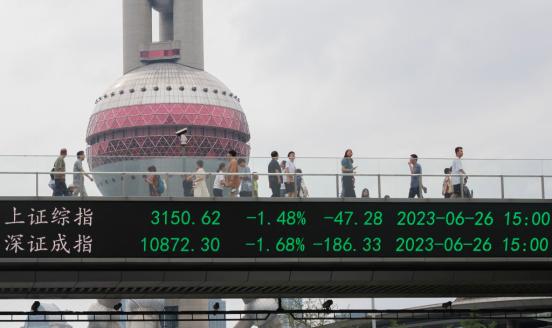China’s Coronavirus will not lead to recession but to stimulus and even more debt
The coronavirus outbreak will not lead to recession but the costs of ensuring growth targets will be high
The outbreak of coronavirus has struck yet another blow to the Chinese economy after the improvement in business confidence since the Phase One trade deal was announced in mid-December. How severe the coronavirus may be for the Chinese economy will not only depend on the extent and depth of the virus outbreak but also on the government response. The People’s Bank of China immediate and bold reaction to calm markets with the equivalent of USD 170 billion in liquidity injection says it all about the pressure for Chinese policymakers to mitigate the impact of the coronavirus outbreak on financial markets, on sentiment and on the Chinese economy, more generally.
Many take the example of the SARS outbreak in 2003 as a benchmark to estimate the impact of coronavirus on the Chinese economy and beyond. The reality is that China is very different from what it was 17 years ago. First, the service sector, especially service consumption, is China’s key growth engine nowadays, with a contribution to economic growth nearly 40% bigger than it in 2003. Based on the SARS’s experience, the service sector is likely to be more severely affected than the manufacturing sector, especially for transportation, which continues to be an important part of the service economy. The second reason is that investor’s confidence has already been hardly hit by the trade war. The coronavirus is already having a knock-on effect on sentiment which is bound to affect the demand for durable goods, as well as private investment. Beyond this demand shock, we cannot forget that there is a negative supply shock stemming for the large number of companies that have not managed to open their doors in a province, Hubei, which accounts to 10% of total auto production in China and is a key transport nexus for West and East China. Furthermore, the sudden stop of production plants is also extending to other provinces.
Over and above the fact that the large negative demand shock is ,this time around and much more than during SARS, is supply shock as well, the other important difference is that China’s growth was increasing on a structural basis – pushed by the growth of population and urbanization. The opposite is true today. In other words, the coronavirus is hitting a weaker economy than was the case with SARS. Based on the above, and assuming that the peak of the coronavirus outbreak happens in the first quarter -which is a very optimistic assumption - we should be expecting a rapid deceleration of economic activity in the first quarter and gradual stabilization for the rest of 2020. This would clearly bring China to grow well below the growth target announced by Premier Li Keqiang a couple of months ago, namely a growth rate slightly before 6%) and much closer to 5% in not lower.
Li Keqiang’s growth target is not really only his own but actually that, which ensures the achievement of President Xi Jinping’s very important target of the Nation’s Rejuvenation, namely that of doubling China’s GDP from 2010 to 2020. Given the importance of achieving this objective before the People’s Party 100th Anniversary in 2021, it seems clear to me that no effort will be spared to achieve a high enough growth target to achieve this goal. This is why we should all be expecting unequivocally lax demand policies from the Chinese government in the next few days, weeks and months. The bigger the shock now, the larger the policy expansion will be needed to achieve the growth target. Such policy expansion, however, has an important constraint, namely inflation, which will might be pushed higher by the limited supply of certain goods. This means that, in the short run, the PBOC’s may not be able to use the most visible tool, namely interest rates cuts, but rather temporary liquidity injection, as has already been announced, and targeted lending and window guidance to steer the cost of funding down. This is particularly needed for those industries most affected by the coronavirus and we are already seen announcements of targeted PBoC supported to such industries. More generally, the exchange rate might be the most effective demand policy to use and we are already seeing signs of the latter as the RMB quickly goes back to the psychological barrier of 7 RMB to the USD. It seems difficult for Trump to denounce China of current manipulation at such a difficult time so the room is clearly open for more depreciation. Moreover, weaker economic fundamentals and potentially laxer monetary policy will exert downward pressure on the RMB so it will be hard to argue this is not a market-driven process. Finally, fiscal policies in the form of targeted subsidies and potentially infrastructure investment may also be used.
As such, we expect the quick policy reaction to avoid a sharp correction in growth so that the Party’s objective of income doubling can be achieved.. This means that 2020 growth for China may still hover around 5.7-5.5% but with dear consequences. Debt will continue to pile up, for corporates, for the government and even for households, as they are pushed to consume more durable goods with subsidies and discounts. More debt for an already highly indebted country like China can only mean lower potential growth than the road. In that regard, one could argue that the negative consequences of the coronavirus on the Chinese economy may be more medium term than immediate and the reason is simply the large stimulus which I expect will follow and, the unavoidable excessive leverage resulting from it.



